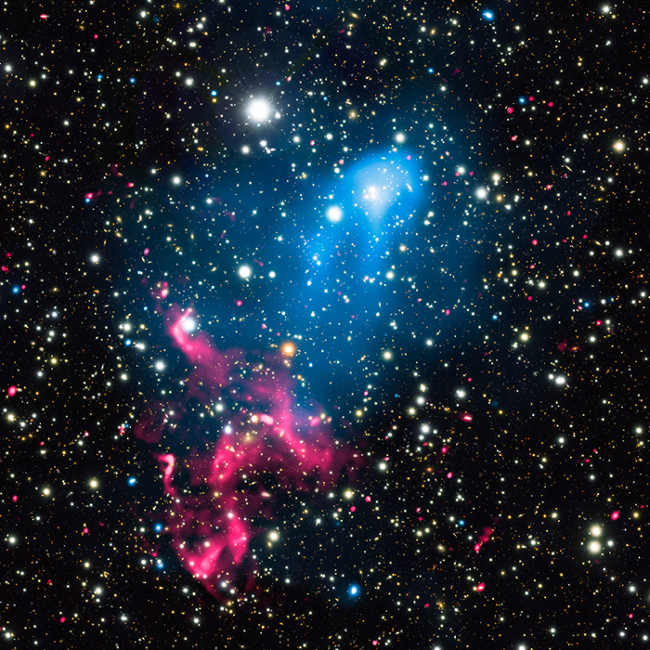
 Credit: X-ray: NASA/CXC/SAO/R. van Weeren et al; Optical: NAOJ/Subaru; Radio: NCRA/TIFR/GMRT
Credit: X-ray: NASA/CXC/SAO/R. van Weeren et al; Optical: NAOJ/Subaru; Radio: NCRA/TIFR/GMRT
Crash on the Cosmic Superhighway
Galaxy clusters are believed to form near the nexus of enormous, unseen filaments which make up the cosmic web of matter which holds the Universe together. Matter (light and dark) flows along these filaments and helps clusters grow. Clusters also grow when individual clusters collide and merge. One such merger is shown in the image above. This image shows a composite of X-ray (blue), optical (red, green, blue), and radio (pink) emission from a collision of two galaxy clusters known as Abell 3411 and Abell 3412. The individual galaxies that make up each cluster can be seen optically, while X-ray emission shows the large amount of hot gas energized by the collision of these two clusters. The bright "head" of the X-ray emission shows the hot gas from one cluster (moving towards the upper right in the image) plowing through the hot gas of the other cluster. The radio emission seen towards the lower left of the image is produced by a large population of electrons moving near the speed of light. Similar populations of electrons are seen near other galaxy clusters, but the process by which these electrons stay at such high velocities for so long has been a long-standing mystery. The collision of Abell 3411 and Abell 3412, however, provides important clues. The radio, optical and X-ray data suggest that, in this case (and likely in other such clusters as well) an old population of electrons originally accelerated by a jet from a supermassive black hole are kept going by weak shock waves produced by the enormous energy generated by the cluster-cluster collision.
Published: January 16, 2017
<
HEA Dictionary ● Archive
● Search HEAPOW
● Other Languages
● HEAPOW on Facebook
● Download all Images
● Education ● HEAD
>

Each week the HEASARC
brings you new, exciting and beautiful images from X-ray and Gamma ray
astronomy. Check back each week and be sure to check out the HEAPOW archive!
Page Author: Dr. Michael F. Corcoran
Last modified Monday, 26-Feb-2024 17:34:18 EST


